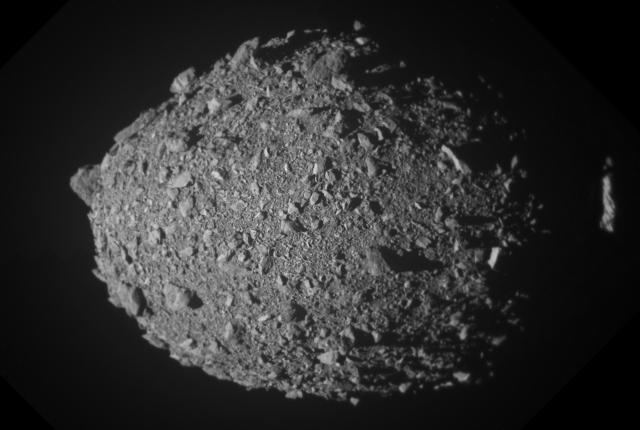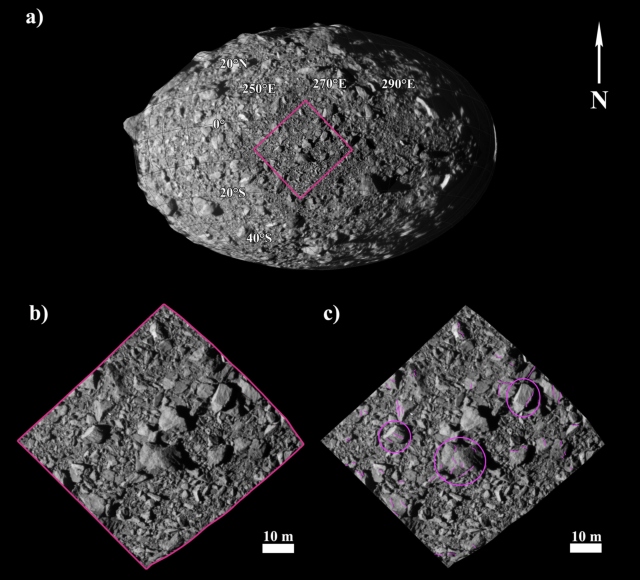Asteroids and planetary defence: on Didymos and Dimorphos, even the boulders talk

High-resolution image of Dimorphos. Counting the boulders on Dimorphos and on its main asteroid Didymos and measuring their size has made it possible to establish that they originated from a common ancestor and that Dimorphos inherited its boulders from its larger companion (Image: NASA/Johns Hopkins APL)
Planetary defence, space debris and near-Earth asteroids: this is the theme of the special edition of Nature Communications, which includes a series of articles analysing the characteristics of the Didymos and Dimorphos asteroid pair, observed up close by DART’s instruments before the spacecraft struck the latter's surface, in a first planetary defence experiment conducted by NASA and ASI. Carried along with DART was LICIACube, a small satellite funded and coordinated by the Italian Space Agency and built by the Turin-based company Argotec, which detached from the spacecraft before impact and followed the effects of the collision.
Of the five articles published in Nature Communications, two are INAF-led and three feature researchers from the University of Bologna’s Radio Science and Planetary Exploration Laboratory. The Italian-led articles focus on the analysis of thermal fractures on Dimorphos' boulders caused by temperature variations between day and night, and on the two asteroids’ formation process through the identification and analysis of the boulders on their surface.
"DART and LICIACube have enabled us to obtain lots of information about Didymos and Dimorphos, but at the same time they have raised many unanswered questions. The complete characterisation of the two asteroids will be carried out by ESA's Hera mission, which will be launched in October 2024 and will reach the asteroids in December 2026," says Paolo Tortora, full professor at the University of Bologna’s Department of Industrial Engineering, Director of CIRI Aerospace, and Principal Investigator of the Hera radio science experiment. "The radio science experiment will make it possible to measure the mass and gravity fields of the two asteroids and study their entire dynamics."
ANAMNESIS AND FAMILY HISTORY OF DIDYMOS AND DIMORPHOS
Closely observing the surface of an asteroid and analysing its geology can tell us a lot about its formation history. Using high-resolution images of Didymos and Dimorphos taken by NASA's DART mission moments before the crash on Dimorphos, scientists have been able to identify all the boulders visible on the surface of the primary asteroid Didymos and the secondary asteroid Dimorphos, studying their size distribution and linking this with various factors such as latitude, longitude, surface slope, gravitational acceleration and exposure to solar radiation.
"Studying the size distribution of boulders larger than 5 metres on Dimorphos, and of those larger than 22.8 metres on Didymos, has allowed us to determine that they were formed as a result of a single fragmentation event – a catastrophic impact – of a parent asteroid," explains Maurizio Pajola, a researcher at INAF in Padua and the first author of the study.
The two bodies are reported to be aggregates of rock fragments formed as a result of the catastrophic destruction of a single common parent. This discovery was also confirmed by the hypervelocity impact simulations carried out in the laboratory and by identifying the largest boulders on the two bodies: measuring 16 metres on Dimorphos and 93 metres on Didymos, these values are equivalent to about one tenth of the size of the asteroid on which they are located. Such large boulders could not have been formed following an impact on the surface of the two bodies, as they would have disintegrated in the collision.
THE LEGACY OF DIMORPHOS
So we have two asteroids with one common parent. But that’s not all: the size distribution of the boulders on the two bodies has turned out to be very similar, suggesting that Dimorphos, the smaller of the two, which orbits around Didymos, inherited its boulders from its companion. How? Through the so-called YORP effect.
"Basically, as an asteroid rotates on itself, its surface is heated by the sun and then cools unevenly, since its geology is complex and irregular," explains Marco Zannoni, a researcher at the Department of Industrial Engineering and the technical manager of the activities assigned to the University of Bologna. "The result is that thermal radiation is emitted asymmetrically, generating torque that in turn can cause the rotation to accelerate or slow down."
According to the researchers, Didymos may have rotated faster in the past and, upon slowing down as a result of the YORP effect, ejected some boulders to form Dimorphos. This scenario is supported by at least two observational evidences: the first on Dimorphos, which has a similar size distribution to that of the primary asteroid; the second on Didymos, which has lower boulder density at the equator.
a) High-resolution mosaic of Dimorphos; the pink box shows the area analysed in the article by Lucchetti et al. (2024); b) Close-up of the image acquired 1.818 s before the DART’s collision, in which boulder fractures are visible and identifiable; c) Boulder fractures mapped by Lucchetti et al. (2024). The largest boulder shown (6.62 m in diameter), Atabaque Saxum, has six fractures on its surface (Image: NASA/Johns Hopkins APL)
THERMAL FRACTURES
The image acquired by DRACO (Didymos Reconnaissance and Asteroid Camera for Optical navigation) on board DART shortly before impact, with its resolution of 5.5 cm on the surface of Dimorphos, also made it possible to see fractures on Dimorphos' rocks with lengths varying from 0.4 to 3 metres, according to the study led by Alice Lucchetti, a researcher at INAF in Padua.
"We mapped the fractures manually, measured their length and orientation, and noticed that they almost all seem to point in the same direction (north west-south east)," says Lucchetti. "This is indicative of the action of thermal stress on these rocks because if they were caused by landslides or impacts, they would all point in different directions."
A thermophysical model has shown that thermal stresses can fracture the rocks on Dimorphos over a period of 10,000 to 100,000 years. Understanding how thermal fatigue acts on small bodies is important, not only to understand the formation and evolution of the Solar System, but also for planetary defence. To predict the effectiveness of a kinetic impactor such as DART, it is essential to understand the behaviour of boulders on the asteroid's surface.
The University of Bologna is involved in the DART and Hera missions through the Radio Science and Planetary Exploration Laboratory and the Microsatellites and Space Microsystems Laboratory, which conduct their activities at the Forlì Technopole, where researchers from CIRI Aerospace and the Department of Industrial Engineering operate.






